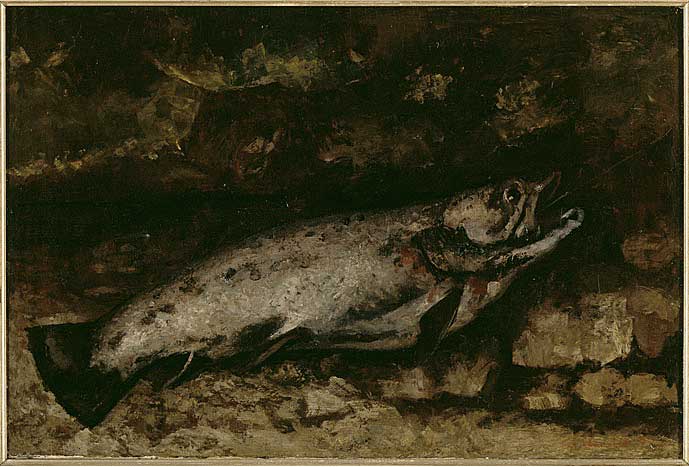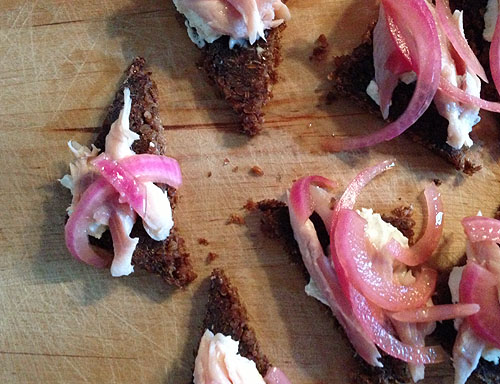Smørrebrød is the Danish tradition of open-face sandwiches. A dark dense bread, usually a type of rye, is toasted and topped with smoked or pickled fish and other vegetables. In this version, the smoked trout is the star and so it is essential to purchase high-quality fish. I picked up a whole fish and carefully de-boned all of the flesh before assembling the smørrebrød. If you have any extra pickled red onions, store them in their pickling liquid in the refrigerator and consume within a week. They are great toppings for hamburgers and can be used to liven up a grilled cheese sandwich.

The Trout (1873) was painted during a period of time Gustave Courbet spent in the Franche-Comté region. The painting is one of several created after he served time in prison due to his participation in the 1871 Commune. Like Édouard Manet‘s earlier painting Fish (Still Life) (1864), Courbet’s trout is dramatically depicted mid-flop. The Trout appears to be freshly caught, gasping for breath on a riverbank and the canvas is worked with heavy and rough brushstrokes. The application of paint paired with the helplessness of the subject could suggest the frustration the Artist was experiencing at the time with the judiciary system.

Smoked Trout Smørrebrød
Adapted from Bon Appetit
Yield: 12 servings
1/2 red onion, sliced thinly
1/4 red wine vinegar
1 Tablespoon granulated sugar
1/2 teaspoon salt
12 slices pumpernickel bread, toasted and quartered
1 teaspoon lemon zest
freshly ground black pepper
1/2 cup crème fraîche
250 grams smoked trout
dill
In a small bowl, combine the red onion with the vinegar, sugar, salt and 1/4 cup hot water. Let sit for 30 minutes
In another bowl, combine the lemon zest, black pepper and crème fraîche. Spoon the mixture on the toasted pumpernickel bread. Add a few grams of fish and top with pickled onions.
Garnish with a bit of dill and serve.

8 comments
Megan Fizell (@mfizell) says:
Mar 15, 2013
Gustave Courbet – Smoked Trout Smørrebrød http://t.co/QU3VEpndIU #food #art
Megan Fizell (@mfizell) says:
Mar 15, 2013
Recipe for Smoked Trout Smørrebrød inspired by Gustave Courbet’s still life painting ‘The Trout’ at @MuseeOrsay http://t.co/rlEGbnmwZl
Rosa says:
Mar 15, 2013
That painting is fabulous and your Smørrebrød looks ever so scrumptious (gotta love those Scandinavian dishes)!
Cheers,
Rosa
Julie says:
Mar 17, 2013
What the heck did Jon eat?
Kitchen Butterfly says:
Apr 22, 2013
I still love and admire your food pairings! I’d love to share some Nigerian art with you….(note to self – keep eyes out for art/artists and potential food pairings). This looks delicious, and love Gustave’s painting
Jon says:
May 13, 2013
Awesome
Fishslice says:
May 18, 2013
purple monkey dishwasher
Hélène Michel says:
Feb 14, 2014
Beautiful beautiful beautiful.